Selecting the Right Bamboo is Crucial for Traditional Filipino Instruments****
Three types of bamboo are commonly used: buho, kawayan tinik, and kawayan kiling. The choice of bamboo depends on the specific instrument being made. Nodes are essential, as they provide the necessary structure and resonance for the instruments.
Basic Tools Required
A bolo (knife), drill, and sandpaper are the fundamental tools needed to craft these instruments.
Crafting Specific Instruments
To make a kubing, carve a frame and lamella from the selected bamboo. For a bungkaka, attach varying lengths of bamboo tubes to a frame. Gabbang keys are cut from mature bamboo culms and fitted into a wooden frame. Diwas tubes, typically 10-20 inches long, are closed at one end. Smooth all edges to ensure the instruments produce a clear sound.
Finishing Techniques
Proper finishing techniques, including the use of dyes and resins, can enhance both the sound and cultural significance of the instruments.
Gathering Your Materials
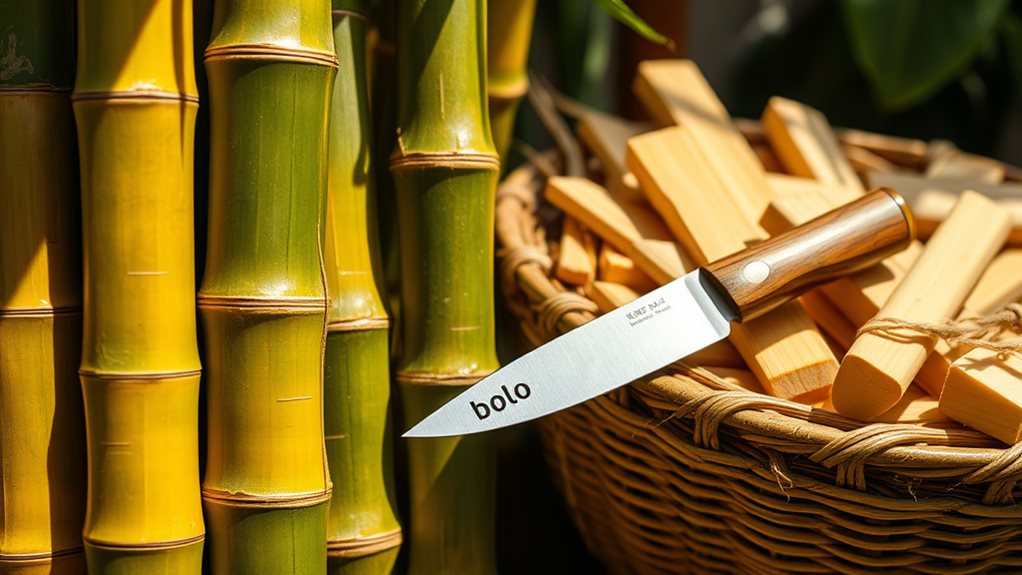
Crafting a Filipino bamboo instrument begins with careful material selection**. The type of bamboo used is crucial, as it directly affects the instrument's sound and longevity. For instruments like the *kubing*, buho bamboo is preferred due to its durability and hollow structure**.
When selecting bamboo, choose stalks that are 45 cm to over a meter long and 3.5 cm in diameter, depending on the instrument's design. Nodes are essential for creating closed ends or unique sound features.
Beyond bamboo, other materials are necessary for crafting certain instruments. Hardwood is required for handles or frames in instruments such as the *bungkaka*. Rattan or twine is used to secure multiple bamboo pieces, as seen in the *bungkaka* or *patteteg*.
Abaca fiber is used for stringing the *Isneg onabir* violin, while steel wire or pineapple fiber may serve as strings for other instruments. Leather is also needed for mouthpieces or straps.
Sustainable bamboo sourcing from local forests or plantations is essential. Always choose fresh, straight, intact bamboo for the best results.
Careful planning in material selection ensures that you have everything needed before starting the intricate crafting process.
Crafting the Kubing
Crafting the Kubing: A Traditional Filipino Instrument****
To initiate kubing construction, two crucial steps are required: selecting the right bamboo and shaping the instrument's frame**. Understanding the kubing's history is essential in choosing the right bamboo, as specific types favored by groups like the Maguindanaon contribute to the instrument's unique tonal qualities**.
Choosing the Right Bamboo
The right bamboo is essential for the kubing's sound production. Traditionally, the Maguindanaon people favored specific bamboo types for their kubing. These types of bamboo contribute to the instrument's unique tonal qualities.
Shaping the Instrument's Frame
Using a sharp knife, carefully carve the frame to the specified dimensions: approximately 25 cm in length, with a 1-inch-wide handle.
The dimensions of the frame directly influence the instrument's pitch**. The lamella**, around 4.5 inches long, is integral to the kubing techniques involved in sound production. It's carved directly into the frame, fixed at one end to allow for flexible vibration.
Finishing the Frame
Precision is paramount in kubing construction. The frame and lamella's dimensions directly influence the instrument's pitch. Smooth the edges with a file or sandpaper for a comfortable playing experience.
Cultural Significance of the Kubing
The kubing's cultural significance extends beyond its musical function. It's used in courtship and ceremonies, underscoring its importance in Filipino traditions****.
The kubing, also known as kobing or kolibau depending on regional variations, embodies centuries of crafting expertise passed down through generations.
Making the Bungkaka
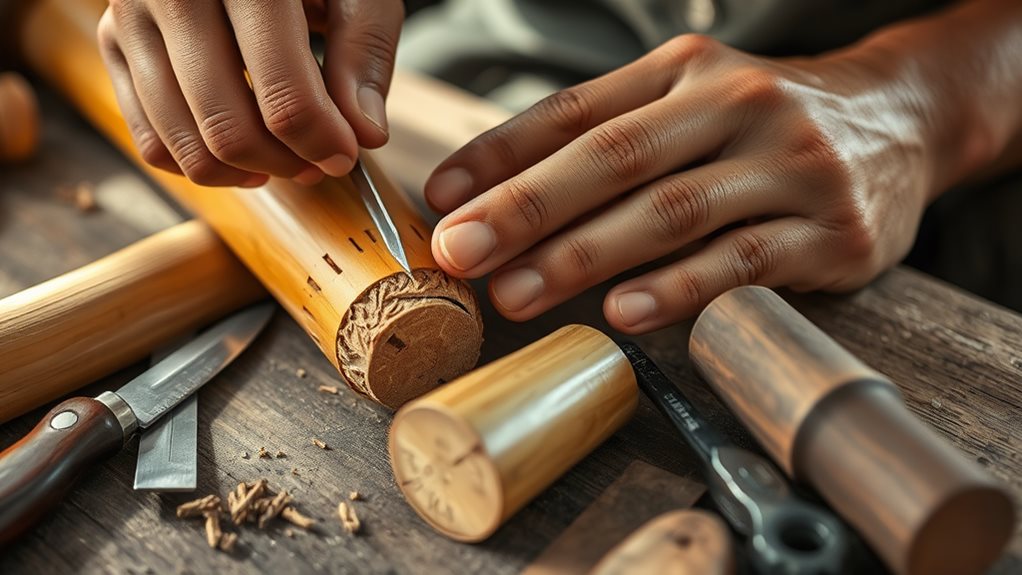
The Bungkaka is a percussion instrument native to the Philippines, composed of multiple bamboo tubes of varying lengths and diameters. Its unique sound is achieved by binding these tubes together, creating a percussive instrument essential to Filipino musical heritage.
To make a bungkaka, carefully select bamboo tubes of varying lengths and diameters, considering their role in achieving the desired tonal range. Bungkaka variations exist across different regions, reflecting local preferences and available materials.
Attach the tubes to a handle or frame using adhesive or twine**, ensuring they're securely fastened** and evenly spaced.
Refining the instrument's sound involves adjusting tube lengths to fine-tune pitch and resonance, crucial for achieving a clear, vibrant sound.
Smoothen any rough edges to ensure a comfortable and safe playing experience.
Playing techniques involve striking the tubes with hands or mallets, producing diverse sounds and rhythms integral to the instrument's cultural context. Experiment with different striking techniques to master the bungkaka's unique voice.
Constructing the Gabbang
Constructing a gabbang requires careful attention to detail and traditional techniques. Bamboo sourcing is the first step, where you'll select mature culms of the right diameter and density for the keys. The choice of bamboo species is crucial, as some are traditionally preferred for their tonal qualities.
To create the keys, cut and shape each one to the correct length and profile, ensuring consistent thickness for even resonance. This process helps to achieve a balanced sound in the finished instrument.
The next step is to construct the wooden frame**, shaping it into the characteristic coffin-like form. This shape contributes to the instrument's resonating properties, making it essential for producing the desired sound. Securely attach the carefully tuned bamboo keys** to the frame, ensuring they're properly aligned and spaced.
You'll also need to incorporate bamboo or wooden nodes to strengthen the structure and close the ends of the frame.
For the mallets, attach rubber strips to sturdy handles. These strips soften the impact on the bamboo keys, producing a richer, mellower tone. Proper tuning is crucial, as each key must be precisely adjusted to create harmonious intervals****. This step is essential for bringing out the instrument's distinctive sound, which is deeply connected to Mindanao's musical traditions.
When the gabbang is complete, it's a testament to meticulous craftsmanship and cultural heritage. The finished instrument is ready to play, with its unique sound and traditional characteristics.
Creating the Diwas
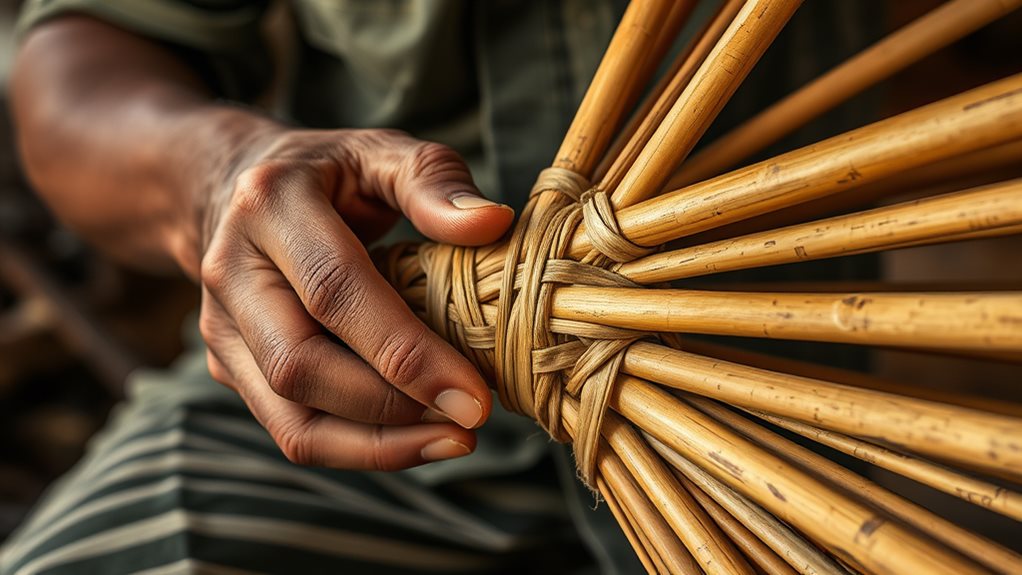
Creating a Diwas: A Step-by-Step Guide****
Constructing a diwas requires selecting the right materials and understanding the instrument's sonic properties. The diwas is made from hollow tubes or segments of bamboo or wood, which are arranged to produce distinct tones. Each tube corresponds to a specific pitch, creating a pan-flute-like effect.
Selecting and Cutting the Materials
To start, you'll need to select bamboo or wood with optimal sonic properties. You'll also need various lengths of hollow tubes or segments and bamboo nodes for closing one end. Measurements for the tubes generally range from 10-20 inches.
Cut the bamboo to the required lengths using sharp cutting tools for precision. Then, smooth and shape the tubes using traditional techniques to enhance sound resonance.
Assembling the Diwas
Closing one end of each tube with a bamboo node is crucial for creating the necessary resonance.
Attach the tubes to a frame or handle, ensuring even spacing. Precision is key in achieving the desired sound quality. Fine-tuning is achieved through careful selection of bamboo with optimal density, precise cutting to achieve accurate lengths, and application of specific tuning techniques to adjust pitch.
Testing and Maintaining the Diwas
Test the instrument to make necessary adjustments and achieve the correct pitch.
Play the diwas by blowing into the open ends, each tube producing a unique melodic note****. Regular cleaning maintains sound quality, and storing it in a dry place prevents damage from moisture. Periodically inspect the diwas for any wear or cracking.
The Significance of the Diwas
The diwas is a testament to Filipino ingenuity, blending nature's sound with human craftsmanship. Its unique sound and construction make it a valuable part of the country's cultural heritage.
Assembling the Tongatong
The tongatong is a percussion instrument that showcases Filipino ingenuity through its unique sound production. To assemble a tongatong, arrange bamboo poles vertically, taking into account their varying lengths, as longer poles produce lower pitches and shorter poles produce higher pitches. This arrangement enables the instrument to produce complex rhythmic patterns.
Accurate cutting is crucial for precise pitch alignment, which is necessary for harmonious ensemble playing. Traditionally, the tongatong is played in groups, and the overall sound should be considered when arranging the poles. To play the instrument, strike the poles against the ground to create resonant tones. Experimenting with striking different sections of the poles can help modulate the sound.
There are no set tuning techniques for the tongatong; instead, the focus is on achieving the desired tonal balance within an ensemble. To add texture to the rhythmic patterns, partially muffle the sound with your hand.
Understanding the physics of sound and the cultural significance of the instrument is essential to assembling the tongatong. Ensure the setup is stable yet easy to manipulate when playing. This will result in an instrument capable of generating an exciting array of percussive sounds.
Essential Tools
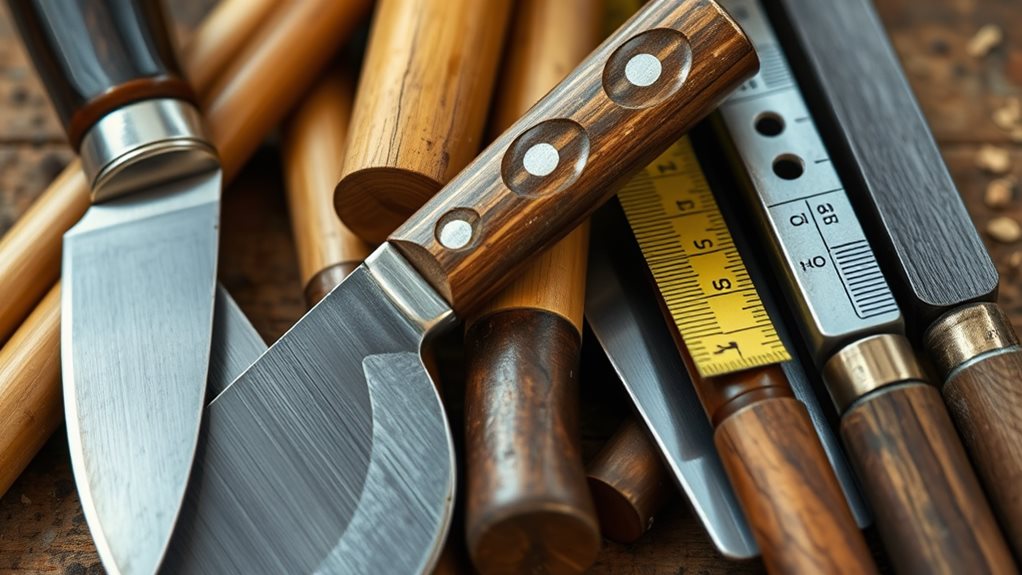
Selecting the Right Bamboo is Crucial for Assembling a Filipino Bamboo Instrument****
Assembling a Filipino bamboo instrument begins with selecting straight, mature stalks of *kawayan tinik* or *kawayan kiling*. To do this, identify stalks with minimal knots and cracks. Harvesting during the dry season ensures optimal moisture content. The diameter of the bamboo will vary depending on the instrument's specific parts.
A Comprehensive Cutting Tools Guide is Essential
A sharp bolo or machete is necessary for initial cuts, while a miter box ensures accuracy in creating specific lengths.
A sharp bolo or machete is used for precise cutting of bamboo to desired lengths and shapes. Sandpaper or a file smoothens rough edges. For hollowing, an adze or drill is used.
The Essential Toolkit****
The essential toolkit for assembling a Filipino bamboo instrument includes:
- A sharp bolo or machete for precise cutting of bamboo to desired lengths and shapes.
- A drill with various sized bits for creating accurately sized holes for fingerings, stringing, and internal partitions.
- Sandpaper and files for refining edges and smoothing surfaces for a polished, professional finish.
Creating Holes and Nodes Requires Precision
Creating holes and nodes requires precision.
A drill or a sharp object is used for precise hole placement****. These are critical for fingerings, stringing, and the instrument's resonant properties. Node positions must be adjusted for accurate tuning.
Attaching strings often involves using bamboo pins, nails, or traditional adhesives. Tuning pegs can be made from wood or bamboo.
Decorative Finishes
Filipino Decorative Finishes: Exploring Natural Materials and Techniques
Filipino decorative finishes often utilize natural materials to achieve unique colors and textures. Plant-based dyes, such as indigo and turmeric, are commonly used to create a range of colors. For example, indigo can produce shades of blue, while turmeric can create hues of yellow and orange. Additionally, natural stains from coconut husks or mango bark can add texture and subtle hues to the instrument.
Protective Finishes and Natural Materials
A protective and glossy finish can be achieved by applying tree resins or beeswax. Tree resins, derived from sap, enhance the bamboo finishes and add a layer of durability. Similarly, beeswax can provide a natural barrier against the elements. Mixing natural dyes with organic materials can create unique shades and patterns, which can be further enhanced by sun exposure and smoke.
Intricate Carving Techniques and Cultural Symbolism****
Intricate carving techniques using sharp tools allow artists to add tribal patterns and cultural symbols to the instrument. Incorporating bamboo nodes and natural knots into designs can create unique and meaningful patterns. Carving animal shapes or mythological figures can imbue the instrument with cultural symbolism, as long as the carvings don't compromise functionality.
Traditional Paints and Lacquers
Traditional paints, made from clay, charcoal, and plant extracts, can add vibrant color to the instrument, reflecting its heritage. Protective lacquers, derived from tree sap, enhance the bamboo finishes and add a layer of durability. Layering paints can create a glossy sheen, and choosing colors with cultural significance can add depth to the instrument's design.
Decorative Embellishments
Decorative beads, crafted from seeds, shells, or wood, can enhance the visual and rhythmic appeal of the instrument. Adding feather decorations or other organic materials can create a unique and meaningful design. Stringing small bells or rattles can add musical accents, while woven fibers and threads can create intricate patterns. Incorporating metal pieces, like brass or copper, can further embellish the instrument.
Instrument Care Tips
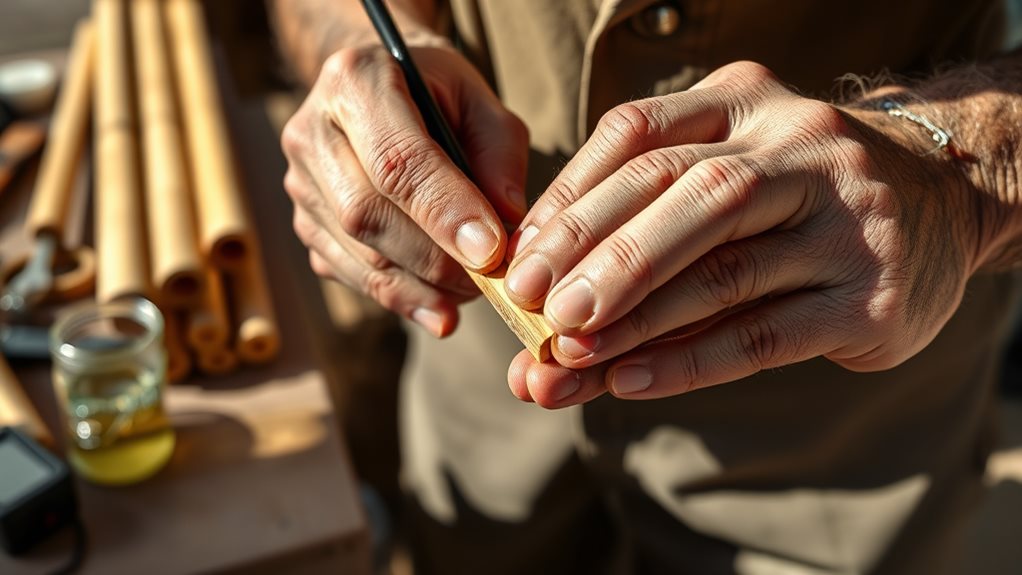
Proper Storage for Handcrafted Filipino Bamboo Instruments****
Proper storage for handcrafted Filipino bamboo instruments is essential for preserving their longevity and cultural significance.
Store the instrument in a dry, cool place, away from direct sunlight and protected within a hard case. This helps prevent damage from environmental factors.
When handling the instrument, use soft cloths to prevent oil transfer from your skin, which can cause damage over time.
Gentle Cleaning Methods
Cleaning handcrafted Filipino bamboo instruments requires gentle methods to avoid damage.
Use a soft, dry cloth for dusting. For deeper cleaning, use a mild soap solution and a soft-bristled brush, ensuring thorough drying afterward.
Avoid soaking the instrument, as it can cause irreparable damage. Regular inspection for cracks or splits is vital, and applying a small amount of natural oil, such as coconut or olive oil, can help maintain its condition.
Tuning Techniques
Tuning techniques vary depending on the instrument, but always proceed carefully.
For stringed instruments, replace strings periodically to maintain sound quality.
When tuning, follow these key points:
- Tune in a quiet space to ensure accurate tuning.
- Consult traditional methods for your specific instrument to avoid damage.
- Avoid abrupt adjustments, as they can cause damage to the instrument.
Performance Practices
Performance practices are integral to preserving both the instrument and its cultural significance.
Warm up the instrument before playing to prevent damage. Use proper techniques to avoid damage and maintain sound quality.
Avoid overplaying, as it can cause wear and tear on the instrument. Respect for tradition dictates mindful use, ensuring future generations can appreciate these beautiful instruments.
Questions and Answers
Where Can I Source Bamboo?
Bamboo can be sourced from local farms, retailers, or even your own garden.
Consider sourcing bamboo from local farms that practice sustainable and environmentally responsible harvesting methods. This approach helps reduce carbon footprint and supports the local economy. Retailers who specialize in bamboo products may also have a variety of options available, including sustainably sourced materials.
If you have the space and climate, consider growing your own bamboo in your garden. This not only provides a readily available source of bamboo but also helps reduce your environmental impact.
What Type of Bamboo Is Best?
The best bamboo type depends on the specific instrument being made. When selecting a bamboo type, consider the desired properties of strength, straightness, node spacing, and thickness. For example, instruments requiring strong and straight bamboo, such as flutes, benefit from species with these characteristics. Philippine bamboo species are often ideal due to their suitable properties. Assessing bamboo properties beforehand is crucial to ensure the chosen type meets the instrument's requirements.
How Durable Are These Instruments?
Instrument durability is heavily influenced by construction techniques and materials. The quality of craftsmanship and the choice of materials significantly impact an instrument's lifespan. For instance, a violin made from high-quality woods and crafted with precision can last for centuries, whereas a poorly constructed instrument may have a much shorter lifespan.
Proper care is essential to maintaining sound quality. Regular maintenance tasks, such as polishing, cleaning, and adjusting the instrument, can help preserve its sound quality and overall condition. By following a routine maintenance schedule, musicians can help extend the life of their instrument.
Instruments can be quite resilient with diligent maintenance. With proper care and attention, many instruments can last for generations. For example, a well-maintained piano can remain in excellent condition for over 50 years, while a violin can last for centuries with regular maintenance and repairs.
Can I Use Synthetic Materials?
Using synthetic materials can affect the sound quality and cultural authenticity of an instrument. Traditional materials are preferred because they provide better resonance and maintain historical significance. For example, a guitar made from synthetic materials may lack the rich tone and warmth produced by a guitar made from natural wood. This is due to the unique properties of natural materials, such as the grain pattern and density of the wood, which contribute to the instrument's distinct sound.
How Do I Repair a Broken Instrument?
To repair a broken instrument, proper assessment and precise techniques are essential. First, evaluate the extent of the damage to identify the broken components and the necessary materials for repair. This assessment will help you determine whether you can fix the instrument yourself or if professional assistance is required.
Gather the necessary materials and tools, such as replacement strings, glue, or specialized equipment, depending on the type of instrument and the nature of the damage. For example, if a string on your guitar is broken, you will need a replacement string of the same gauge and type. If the bridge of your violin is damaged, you may need specialized adhesive and clamps to reattach it.
Meticulously repair the broken components, following established techniques and guidelines for your specific instrument. For instance, when repairing a cracked violin body, apply a small amount of adhesive to the affected area and clamp it securely to prevent further damage. When restringing a guitar, ensure that the new strings are properly seated and tuned to avoid damage to the instrument or injury to yourself.
Ensure proper reassembly and tuning after completing the repairs. This may involve consulting the instrument's manual or seeking guidance from a professional if you are unsure about the correct procedure. For example, when reassembling a clarinet, make sure that all the keys and pads are properly aligned and functioning correctly before tuning the instrument.